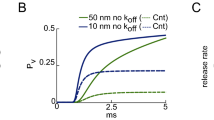Abstract
In this paper a mathematical description of a presynaptic episode of slow synaptic neuropeptide transport is proposed. Two interrelated mathematical models, one based on a system of reaction diffusion partial differential equations and another one, a compartment type, based on a system of ordinary differential equations (ODE) are formulated. Processes of inflow, calcium triggered activation, diffusion and release of neuropeptide from large dense core vesicles (LDCV) as well as inflow and diffusion of ionic calcium are represented. The models assume the space constraints on the motion of inactive LDCVs and free diffusion of activated ones and ions of calcium. Numerical simulations for the ODE model are presented as well. Additionally, an electronic circuit, reflecting the functional properties of the mathematically modelled presynaptic slow transport processes, is introduced.
Similar content being viewed by others
References
Adams PR, Jones SW, Pennefather P, Brown DA, Koch C, Lancaster B (1986) Slow synaptic transmission in frog sympathetic ganglia. J Exp Biol 124: 259–285
Ashby WR (1958) An Introduction to Cybernetics. Chapman & Hall Ltd, London
Aristizabal F, Glavinovic MI (2004) Simulation and parameter estimation of dynamics of synaptic depression. Biol Cybern 90: 3–18
Beal MF, Mazurek MF, Chattha GK, Svendsen CN, Bird ED, Martin JB (1986) Neuropeptide Y immunocreativity is reduced in cerebral cortex in Alzheimer’s disease. Ann Neurol 20: 282–288
Beal MF, Clevens RA, Mazurek MF (2004) Somatostatin and neuropeptide Y immunoreactivity in Parkinson’s disease dementia with Alzheimer’s changes. Synapse 2(4): 463–467
Bertrand PP, Thomas EA, Kunze WAA, Bornstein JC (2000) A simple mathematical model of second-messenger mediated slow excitatory postsynaptic potentials. J Comput Neurosci 8: 127–142
Bielecki A, Kalita P, Lewandowski M (2006a) Model of fast synaptic transmission. In: Proceedings of the 12th national conference on application of mathematics in biology and medicine. Kraków, Poland, pp 13–18
Bielecki A, Skomorowski M, Woźniak R (2006) Electronic neural networks modelling. In: Cader A, Rutkowski L, Tadeusiewicz R, Żurada J (eds) Artificial intelligence and soft computing. Series: challenging problems of science—computer science Bolc L (ed). Academic Publishing House EXIT, Warszawa, Poland, pp 8–14
Bielecki A, Kalita P (2008) Model of neurotransmitter fast transport in axon terminal of presynaptic neuron. J Math Biol 56(4): 559–576
Boyd IA, Martin AR (1956) The end-plate potential in mammalian muscle. J Physiol 132: 74–91
del Castillo J, Katz B (1954) Quantal components of the end-plate potential. J Physiol 124: 560–573
Donahue BS, Abercrombie RF (1987) Free diffusion coefficient of ionic calcium in cytoplasm. Cell Calcium 8: 437–448
Friedman A, Craciun G (2005) A model of intracellular transport of particles in an axon. J Math Biol 51: 217–246
Gabriel SM, Davidson M, Haroutunian V, Powchik P, Bierer LM (1996) Neuropeptide deficits in schizophrenia vs. Alzheimer’s disease cerebral cortex. Biol Psychiatry 39: 82–91
Greengard P (2001) The neurobiology of slow synaptic transmission. Science 294: 1024–1030
Han W, Ng YK, Axelrod D, Levitan ES (1999) Neuropeptide release by efficient recruitment of diffusing cytoplasmic secretory vesicles. Proc Natl Acad Sci USA 96: 14577–14582
Harmon LD (1961) Studies with artificial neuron—properties and functions of an artificial neuron. Biol Cybern 1: 89–101
Kalkstein JM, Magleby KL (2003) Augmentation increases vesicular release probability in the presence of masking depression at the frog neuromuscular junction. J Neurosci 24: 4127–4134
Keener J, Sneyd J (1998) Mathematical physiology. Springer, New York
Kruckenberg P, Sandweg R (1968) An analog model for acetylocholine release by motor nerve endings. J Theoret Biol 19: 327–332
Levitan ES, Lanni F, Shakiryanova D (2007) In vivo imaging of vesicle motion and release at the Drosophila neuromuscular junction. Nat Protocols 2: 1117–1125
Levitan ES (2008) Signaling for vesicle mobilization and synaptic plasticity. Mol Neurobiol 37(1): 39–43
Magleby KL, Stevens CF (1972) A quantitative description of end-plate currents. J Physiol 223: 173–197
Masuo Y, Morita M, Oka S, Ishido M (2004) Motor hyperactivity caused by a deficit in dopaminergic neurons and the effects of endocrine disruptors: a study inspired by the physiological roles of PACAP in the brain. Regul Pept 123: 225–234
Nagumo J, Arimoto S, Yoshizawa S (1964) An active pulse transmision line simulating nerve axon. Proc IRE 50: 2061–2070
Ng YK, Lu X, Gulacsi A, Han W, Saxon MJ, Levitan ES (2003) Unexpected mobility variation among indyvidual secretory vesicles produces an apparent refractory neuropeptide pool. Biophys J 84: 4127–4134
Oades RD, Daniels R, Rascher W (1998) Plasma neuropeptide—Y levels, monoamine metabolism, electro lyte excretion and drinking behavior in children with attention-deficit hyperactivity disorder. Psychiatry Res 80: 177–186
Rall W (1969) Time constants and electronic length of membrane cylinders and neurons. Biophys J 9: 1483–1508
Scott A (1995) Stairway to the mind. Springer, New York
Scott R, Rusakov DA (2006) Main determinants of presynaptic Ca2+ dynamics at individual mossy fiber–CA3 pyramidal cell synapses. J Neurosci 26: 7071–7081
Shakiryanova D, Tully A, Hewes RS, Deitcher DL, Levitan ES (2005) Activity-dependent liberation of synaptic neuropeptide vesicles. Nat Neurosci 8: 173–178
Shakiryanova D, Tully A, Levitan ES (2006) Activity-dependent synaptic capture of transiting peptidergic vesicles. Nat Neurosci 9: 896–900
Tadeusiewicz R (1994) Problems of biocybernetics. PWN, Warszawa (in Polish)
Virgo L, Humphries C, Mortimer A, Barnes T, Hirsch S, de Belleroche J (1995) Cholecystokinin messenger RNA deficit in frontal and temporal cerebral cortex in schizophrenia. Biol Psychiatry 37: 694–701
Wong M, Shakiryanova D, Levitan ES (2008) Presynaptic ryanodine receptor-CamKII signaling is required for activity-dependent capture of transiting vesicles. J Mol Neurosci (to appear) doi:10.1007/s12031-008-9080-8
Waxman SG (1972) Regional differentation of the axon: a review with special reference to the concept of the multiplex neuron. Brain Res 47: 269–288
Texas Instruments Incorporated (2006) Precision ADC and DACs with 8051 microcontroller and flash memory (Rev. F). http://focus.ti.com/docs/prod/folders/print/msc1211y2.html, Texas Instruments
Author information
Authors and Affiliations
Corresponding author
Rights and permissions
About this article
Cite this article
Bielecki, A., Kalita, P., Lewandowski, M. et al. Compartment model of neuropeptide synaptic transport with impulse control. Biol Cybern 99, 443–458 (2008). https://doi.org/10.1007/s00422-008-0250-0
Received:
Accepted:
Published:
Issue Date:
DOI: https://doi.org/10.1007/s00422-008-0250-0




